Romeo and Juliet versus Bonnie and Clyde. Democracy versus dictatorship.
In-person learning versus remote classes.
What do these pairs have in common?
They’re all topics for a powerful writing tool: the compare and contrast essay.
Wait… did you know Martin Luther King Jr. used a compare and contrast format in his “I Have a Dream” speech?
By contrasting “the promises of the Constitution” with the reality of segregation, he made one of history’s most compelling arguments for change.
In this blog, we’ll cover what exactly a compare and contrast essay is, break down the two main organizational structures, and walk through the writing process step-by-step to help you craft better essays with less stress.
Let’s get started.
What Is a Compare and Contrast Essay?
A compare-and-contrast essay is a type of writing that looks at two subjects side by side to explore how they are alike and how they are different.
The goal isn’t just to spot differences or list similarities – it’s to understand those details deeply and explain why they matter.
For example, suppose you’ve selected a topic “Online school vs. traditional school.”
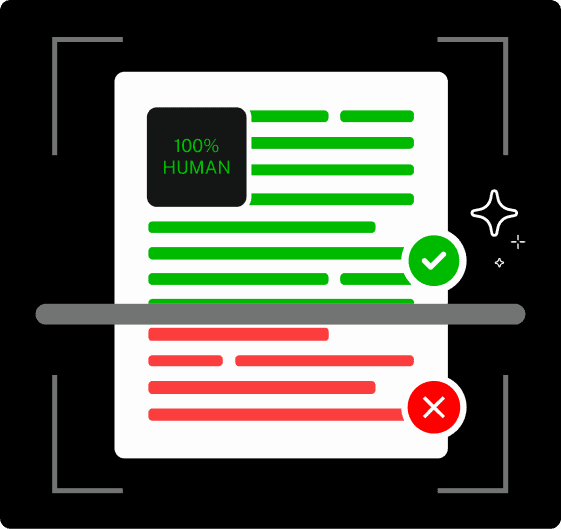
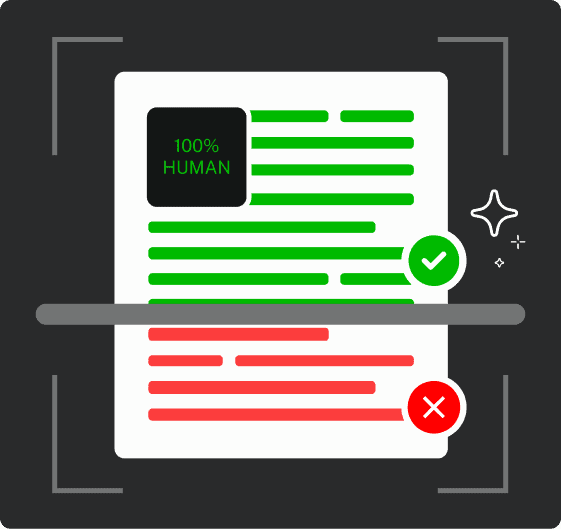
Never Worry About AI Detecting Your Texts Again. Undetectable AI Can Help You:
- Make your AI assisted writing appear human-like.
- Bypass all major AI detection tools with just one click.
- Use AI safely and confidently in school and work.
You start brainstorming pros and cons. What’s easier? What’s more fun? What do they have in common? That thinking process is exactly what compare and contrast essays are built on.
But it doesn’t stop here.
It also teaches you to analyze, make connections, and form your own opinion. Instead of just saying “this is the same” or “this is different,” you start asking:
Why does that difference even matter? What does this similarity say about both sides?
This brainstorming makes the reader feel, think, and see the topic in a brand-new way.
Common Topics for Compare and Contrast Essays
To write a strong compare and contrast essay, you need a topic that fits two important rules:
- The subjects must have enough in common to compare.
- They must be different enough to contrast.
Below is the list of common compare and contrast essay topics.

Check out more topics here >> 127 Compare and Contrast Essay Topics
Compare and Contrast Essay Structure
Once you’ve picked your two subjects, you’re ready to write.
But how do you organize everything so it makes sense? There are two main ways:
Block Method (Subject-by-Subject)
You fully explore Subject A and cover all its important points, and then move on to explore Subject B.
The block method works best when you’re discussing historical events, scientific theories, or literary works where background is the key.
Here’s how to use this method:
- List out key points for both subjects. For example, if you’re comparing online school vs. traditional school, your outline might look like this:
- Online school: flexibility, learning environment, teacher interaction, social life.
- Traditional school: structured schedule, classroom environment, teacher engagement, peer interaction.
- Write all the key points of Subject A in separate paragraphs. For example, describe what online school looks like, how students engage, what challenges they face, and what benefits it brings.
- Do the same thing for Subject B. Instead of copying the same points from Subject B and changing the words, add the layers to the comparison. For example,
- Instead of saying: “Traditional school has face-to-face interactions.”
- You could say: “While online school allows students to engage through discussion boards and video calls, traditional school fosters real-time, face-to-face interactions that help students develop social skills and emotional intelligence in ways that digital platforms can’t fully replicate.”
- Use strong transitions by adding a linking paragraph or transition sentence. For example, instead of jumping straight into Subject B, bridge the gap with something like:
- “Now that we’ve seen how online schools operate, let’s explore the traditional classroom experience and see how it compares in structure, engagement, and student interaction.”
However, be mindful that if you do not tie the two sections together, your essay can feel like two separate pieces instead of one coherent argument.
Point-by-Point Method
Instead of covering one subject at a time, you compare both subjects point-by-point, discussing one aspect at a time before moving on to the next.
This method works best when the subjects have comparable elements (e.g., iOS vs. Android) or when you want to highlight strengths and weaknesses side by side.
Here’s how it’s done:
- Choose key points that can be discussed in direct relation to each other. For example, if you’re comparing iOS vs. Android, your key points might be:
- User interface
- Customization
- Security
- App availability
- Write each paragraph focusing on one key point. Start by discussing how subjects handle that specific aspect before moving to the next. For example, a paragraph on user interface might look like this:
- iOS offers a sleek, user-friendly design ideal for first-time users. In contrast, Android allows more customization – widgets, layouts, and settings – appealing to those who want control. While iOS ensures consistency, Android offers flexibility.
- Avoid favoritism. A strong compare and contrast essay gives both sides equal attention. You can set word limits. For example, if you write four sentences about iOS, match them with four about Android.
- Use smooth transitions. Instead of bluntly switching topics, use phrases like:
- Unlike iOS, which prioritizes simplicity, Android allows…
- While both systems offer security features, iOS takes a stricter approach by…
This method is more engaging because it keeps the reader moving through the essay without needing to “reset” their understanding.
How to Write a Compare and Contrast Essay
Here is the 5-step way to write a compare and contrast essay.
Step 1: Choose Two Subjects
Picking the right subjects is half the battle. Your comparison will only be strong if the subjects have something worth comparing.
We’ve touched on the two core factors of a good topic in the upper sections.
Let’s find out how to find the right subject:
- Comparable – They should serve similar purposes or belong to the same category.
- Interesting – Topics with real-world impact or current relevance work best.
- Not too obvious – Avoid cliché comparisons unless you have a fresh take.
- Balanced – If subjects are too similar or too different, the essay falls flat.
For example,
Good vs. Poor Subject Pairings
Good: Public vs. Private Schools (different but share the same purpose)
Poor: Public schools vs. Video Games (no connection)
Good: Instagram vs. TikTok (similar in function, different in execution)
Poor: Instagram vs. Chess (completely unrelated)
Here’s a quick gut check before you choose. If you answer “yes” to all three questions, you’re ready to go.
- Can I explore three meaningful points?
- Does the topic matter or make people think?
- Can I make the reader care?
Step 2: Brainstorm Similarities and Differences
Once you have your subjects, it’s time to break them down. An easy trick is to use the “Venn Diagram Method” to make brainstorming easier.
Here’s how to do it:
- Draw two overlapping circles.
- Label one circle Subject A, the other Subject B.
- Write unique traits in the non-overlapping sections.
- Write shared traits in the overlapping middle.
This is great for visual learners.
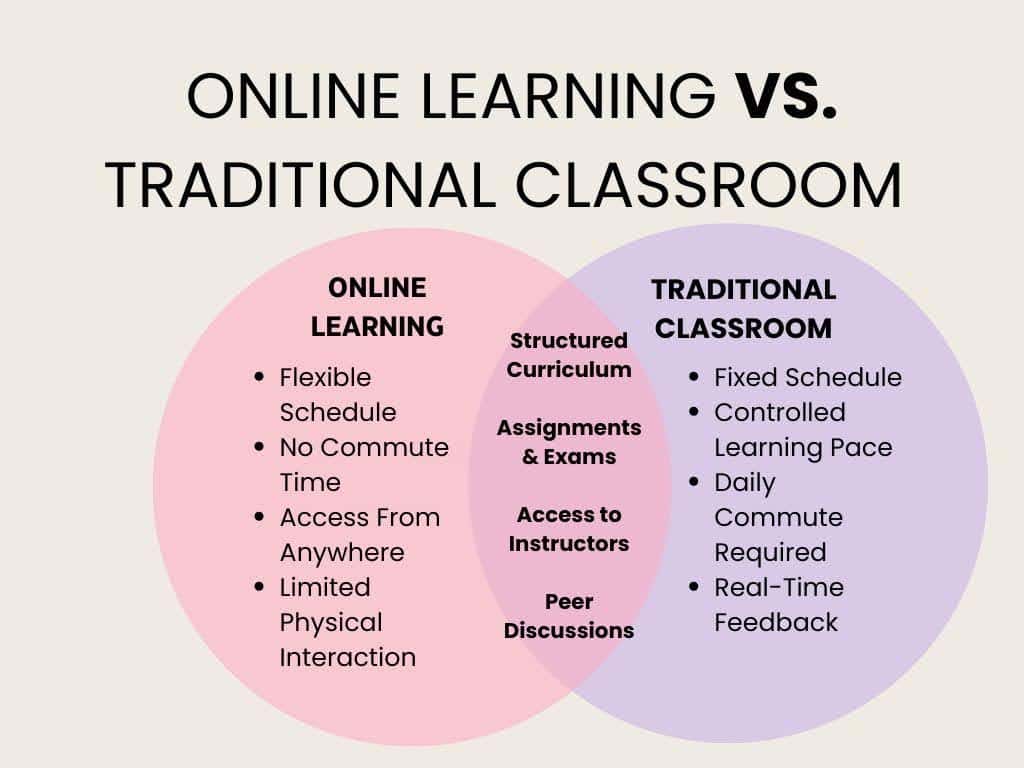
Instead of just asking “What’s different?”, ask:
- Why is this different?
- What does this difference mean for people who use it?
- How does this similarity matter in real life?
If you’re stuck or need some extra help thinking through your comparisons, try using AI Chat.
Here’s how it’ll help you:

- Ask questions by considering it an instructor. For example,
- Instead of asking “What’s the difference between Android and iOS?”
- Ask, “How does the design of Android phones compare to iOS in terms of user experience and accessibility?” or “What are some shared features between traditional education and online schooling that impact students’ learning styles?”
- Refine your brainstorming – Use AI to help you dig deeper into your subjects. You can ask follow-up questions to get more specific insights. For example:
- “Why is flexibility important for online school students?”
- “What are hidden similarities between rural life and urban life?”
You can gather fresh angles on your subjects using AI chat.
This will help you generate thoughtful, well-supported points for your essay.
Step 3: Create a Thesis Statement
A thesis statement is a one-sentence statement that tells the reader what to expect and what your main point will be.
Here’s the formula for a strong thesis:
While A and B share X similarity, they differ in important ways (including Y and Z).
A weak thesis leaves your reader wondering what exactly you’ll compare and why it’s significant.
For example,
Both dogs and cats provide companionship, dogs require more active attention, while cats are more independent.
Step 4: Make an Outline
An outline saves you time because it gives you a roadmap.
There are two ways to organize:
- Block Method
- Intro
- Subject A (all points)
- Subject B (all points)
- Conclusion
- Point-by-Point Method
- Intro
- Point 1 (both subjects)
- Point 2 (both subjects)
- Point 3 (both subjects)
- Conclusion
So which one to choose for your essay?
- Use the Block Method for deep analysis when subjects are complex.
- Use Point-by-Point for clear comparisons when subjects are easy to compare.
Step 5: Write the Essay
Now it’s time to bring all the hard work together.
Here’s how to do it:
- Introduction Strategies
Your introduction sets the stage for the later parts.
These are the crux of a solid introduction:
- Hook the reader. Start with a question, fact, or short story.
- Introduce both subjects and explain why they’re being compared.
- End with a thesis.
- Body Paragraph Structure
Whatever the type you choose, make sure that each paragraph has the same structure:
- Add a topic sentence, and tell what this paragraph is about.
- Show, don’t just tell. Add pieces of evidence and examples.
- Elaborate on each point by telling why it matters.
- Conclusion
A good conclusion doesn’t just repeat the thesis – it synthesizes the argument.
- Instead of saying: As we’ve seen, Subject A and Subject B are different in many ways.
- Try: Ultimately, choosing between online and traditional school depends on a student’s needs. Those who thrive on flexibility may prefer online learning, while those who need structure might find a traditional classroom more beneficial.
Now that you know how to write a compare and contrast essay, you can use an AI Essay Writer to make the process easier.
With the right information, AI can save you time and help you write better.
It helps you organize your thoughts, structure your essay, and improve your thesis.
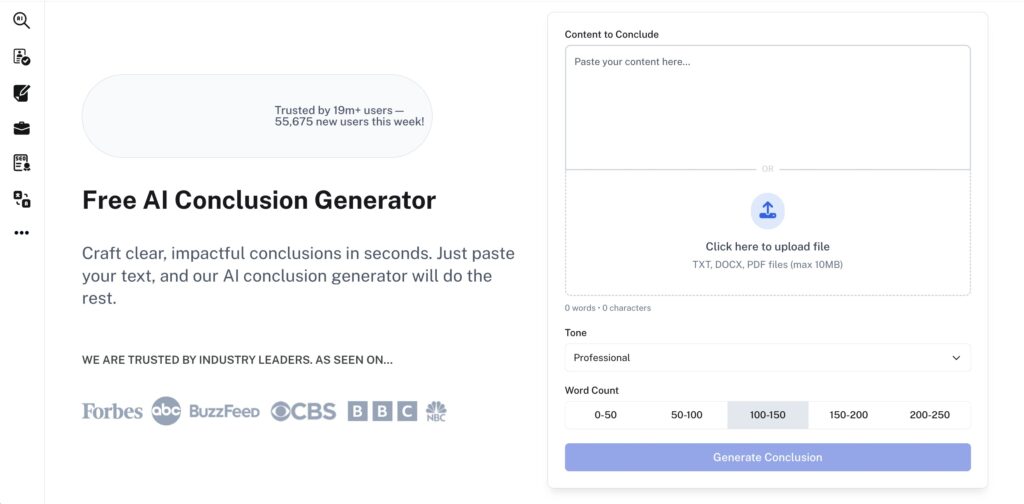
Not sure how to end your compare and contrast essay with clarity and impact?
That’s exactly where our AI Conclusion Generator comes in. It helps you pull together the core similarities and differences from your body paragraphs, then turns them into a powerful final thought that reinforces your thesis.
Think of it as your synthesis shortcut — saving you time while still sounding thoughtful and original. No matter your topic, this tool makes sure your conclusion feels complete, polished, and worth the reader’s time.
Compare and Contrast Essay Example Topics
Let’s explore some great topics, what makes them interesting, and unique ways to approach them.
- Online school vs. traditional school
Education has changed after 2020. Some students learn at home, while others go to a classroom. But which one is better? This depends on what you value more – flexibility or structure.
The difficulty level of this topic is → “EASY” because the differences are clear.
Here are different points of comparison:
- Flexibility – Online school lets students learn anytime, but traditional school has a fixed schedule.
- Social Interaction – Traditional schools offer face-to-face friendships, whereas online students talk through screens.
- Learning Style – Some people focus better at home, while others need a teacher right in front of them.
- Resources – Traditional schools have access to libraries, labs, and sports, while online schools rely on digital tools.
- iOS vs. Android
Everyone has an opinion about iPhone vs. Android. Some people love Apple’s sleek design, while others prefer Android’s customization.
But is one truly better than the other?
Here are different points of comparison:
- Ease of Use – iPhones have a simple, user-friendly design, while Androids offer more customization.
- Price – iPhones are expensive, while Android phones come in all price ranges.
- Updates – Apple controls its updates, but Android users might wait longer for new software.
- App Store & Compatibility – iPhones have strict app rules, while Android allows more freedom.
The difficulty level of this topic is → “MEDIUM” as you need to go beyond personal preference and analyze why these differences matter.
For this topic, you can discuss who each phone is made for instead of just comparing the features.
Why do business professionals often use iPhones? Who do tech enthusiasts love Android?
- Capitalism vs. socialism
These two economic systems shape how money, businesses, and jobs work. Some believe capitalism rewards hard work, while others say socialism ensures fairness.
But which one creates a better society?
- Ownership – In capitalism, businesses are privately owned. In socialism, the government controls major industries.
- Wealth Distribution – Capitalism allows people to get rich, but socialism focuses on reducing wealth gaps.
- Innovation vs. Security – Capitalism encourages competition and new ideas, while socialism ensures basic needs are met.
- Taxes – Capitalist economies usually have lower taxes, while socialist economies use higher taxes to fund public services.
This topic requires strong reasoning skills because it deals with complex ideas. That’s why its difficulty level would be considered → “HARD”
Instead of arguing which system is better, compare how each system affects real people.
How does capitalism shape life in the U.S.?
How does socialism impact countries like Sweden?
How AI Tools Can Help You Write Better
Writing essays and brainstorming ideas are time-consuming, especially when deadlines are tight.
Fortunately, there are AI tools that make the process easier, faster, and more efficient.
- AI Essay Writer
The AI Essay Writer helps you generate full essays in just seconds, allowing you to:
- Create outlines: Automatically structure your essay with a solid framework.
- Produce drafts quickly: Skip the hours of research and writing, and get a solid draft in moments.
- Bypass AI detectors: This tool generates content that sounds natural and can bypass AI detection tools, so your essays remain undetectable and authentic.
- Save time and reduce stress: No more procrastination or rushing to meet deadlines. You’ll be able to write essays with less anxiety.
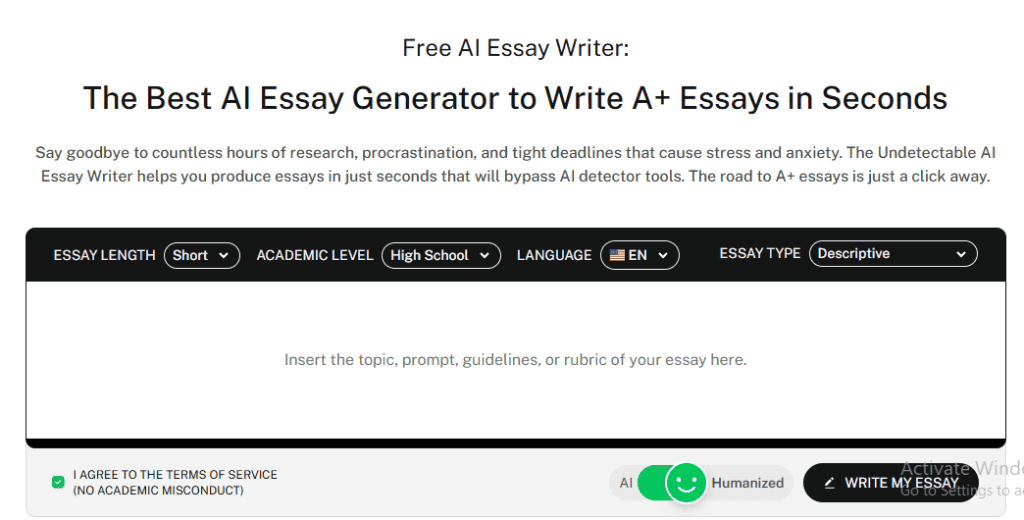
2. AI Paraphraser
The AI Paraphrasing Tool takes your existing content and enhances it by:
- Eliminating repetition: It automatically rewrites phrases and sentences, making your text more varied and dynamic.
- Improving clarity: It rewrites confusing or unclear sentences, making your ideas more readable and easier to understand.
- Humanized text: The tool uses advanced algorithms to make your paraphrased content sound like it was written by a person.

3. AI Chat
The AI Chat can assist if you’re struggling to come up with a compelling essay topic or need more inspiration
- Generating topic ideas: Ask the AI Chat for suggestions on interesting and unique essay topics.
- Engaging discussions: It provides human-like responses that help you explore different angles for your writing.
- Boosting productivity: With AI Chat’s assistance, you’ve saved enough time to focus on writing rather than searching for inspiration.

Experience the power of our AI Detector and Humanizer in the widget below!
Conclusion
In the end, practice makes a man perfect, and writing is no exception.
The more you work at it, the stronger you’ll be able to make clear, compelling arguments and organize your thoughts.
And these skills don’t just stay in the writing world, they spill over into how you think and problem-solve every day.
So, what’s holding you back?
Start drafting your essay today, even if it’s just a rough outline, and watch how your confidence and skills grow with every sentence.
